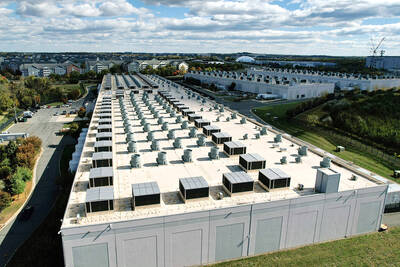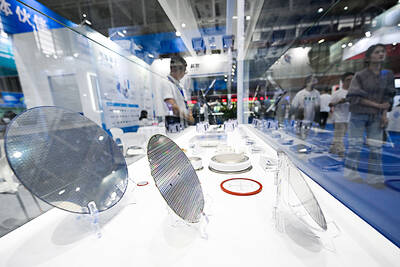Apple Inc assembly partner Pegatron Corp (和碩) is making preparations for its first plant in India, adding to a large influx of foreign tech investments in the country this year.
Last month, the Indian government set out a US$6.6 billion plan to woo the world’s top smartphone manufacturers, offering financial incentives and ready-to-use manufacturing clusters.
Pegatron is now setting up a local subsidiary and joining fellow Taiwanese electronics assemblers Hon Hai Precision Industry Co (鴻海精密) and Wistron Corp (緯創), who have already been making some iPhone handsets in southern India.
With a number of factories in China, Pegatron is the second-largest iPhone assembler and depends on Apple for more than half of its business. Like its peers, it would set up in the south of India, said a person familiar with its plans who asked not to be named.
Hon Hai, also known as Foxconn Technology Group (富士康科技集團), and Wistron are looking to expand their operations in the country, and Pegatron’s entry could be seen as a defensive move to protect its share of budget iPhone manufacturing, Bloomberg Intelligence analyst Matthew Kanterman said.
Pegatron could uphold its iPhone SE assembly market share, which might have grown from a 50-50 split with Hon Hai, Kanterman said.
India offers a vast pool of skilled labor as well as a domestic market of a billion mobile connections. Only about half of those are smartphones, leaving untapped potential that is attractive to growth-hungry global brands like Apple, Samsung Electronics Co, Xiaomi Corp (小米) and Oppo Mobile Telecommunications Corp (歐珀).
For assemblers like Pegatron, exports would also be an enticing opportunity, especially at a time of worsening trade relations between Washington and Beijing making it imperative to have a diverse geographic base.
Smartphones are a focal point for Indian Prime Minister Narendra Modi’s much-touted Make in India program. Indian Minister of Electronics and Information Technology Ravi Shankar Prasad has said the goal is for brands and manufacturers to transport the entire supply chain to the country, not just the end-stage assembly.
Quoted by local media, Prasad said India wants not only the “bridegroom” but also the “wedding procession.”
India would become a global manufacturing hub for both components and the complete assembly of smartphones and other devices, said Pankaj Mohindroo, chairman of the Indian Cellular & Electronics Association.
The group’s three dozen members include Apple, Hon Hai, Google, Wistron, Oppo and others.
“The focus is shifting from making for India to exports and the $400 billion electronics manufacturing that India is targeting by 2025 will be dominated by exports,” Mohindroo said by telephone from New Delhi.

The demise of the coal industry left the US’ Appalachian region in tatters, with lost jobs, spoiled water and countless kilometers of abandoned underground mines. Now entrepreneurs are eyeing the rural region with ambitious visions to rebuild its economy by converting old mines into solar power systems and data centers that could help fuel the increasing power demands of the artificial intelligence (AI) boom. One such project is underway by a non-profit team calling itself Energy DELTA (Discovery, Education, Learning and Technology Accelerator) Lab, which is looking to develop energy sources on about 26,305 hectares of old coal land in

Taiwan’s exports soared 56 percent year-on-year to an all-time high of US$64.05 billion last month, propelled by surging global demand for artificial intelligence (AI), high-performance computing and cloud service infrastructure, the Ministry of Finance said yesterday. Department of Statistics Director-General Beatrice Tsai (蔡美娜) called the figure an unexpected upside surprise, citing a wave of technology orders from overseas customers alongside the usual year-end shopping season for technology products. Growth is likely to remain strong this month, she said, projecting a 40 percent to 45 percent expansion on an annual basis. The outperformance could prompt the Directorate-General of Budget, Accounting and

Netflix on Friday faced fierce criticism over its blockbuster deal to acquire Warner Bros Discovery. The streaming giant is already viewed as a pariah in some Hollywood circles, largely due to its reluctance to release content in theaters and its disruption of traditional industry practices. As Netflix emerged as the likely winning bidder for Warner Bros — the studio behind Casablanca, the Harry Potter movies and Friends — Hollywood’s elite launched an aggressive campaign against the acquisition. Titanic director James Cameron called the buyout a “disaster,” while a group of prominent producers are lobbying US Congress to oppose the deal,

Two Chinese chipmakers are attracting strong retail investor demand, buoyed by industry peer Moore Threads Technology Co’s (摩爾線程) stellar debut. The retail portion of MetaX Integrated Circuits (Shanghai) Co’s (上海沐曦) upcoming initial public offering (IPO) was 2,986 times oversubscribed on Friday, according to a filing. Meanwhile, Beijing Onmicro Electronics Co (北京昂瑞微), which makes radio frequency chips, was 2,899 times oversubscribed on Friday, its filing showed. The bids coincided with Moore Threads’ trading debut, which surged 425 percent on Friday after raising 8 billion yuan (US$1.13 billion) on bets that the company could emerge as a viable local competitor to Nvidia